Civil War Railroads: #2
Civil War Railroads
The first major battle of the Civil War was the First Battle of Bull Run (Manassas), Confederate forces under General Beauregard were losings to the Federals under General McDowell. Losing that is, until General Joe Johnson and General Thomas (Stonewall) Jackson arrived with reinforcements by train from the Shenandoah Valley. The federals were subsequently routed leaving Washington City virtually open to invasion by Southern forces.

Thereafter, the Confederates would repeatedly move troops and equipment to the point of Federal attack. Thus, early in the conflict, railroads became a critical element in the war.
So, realizing the importance of railroads, legislation called the Railroad and Telegraph Act of Jan. 1862 was signed by President Lincoln in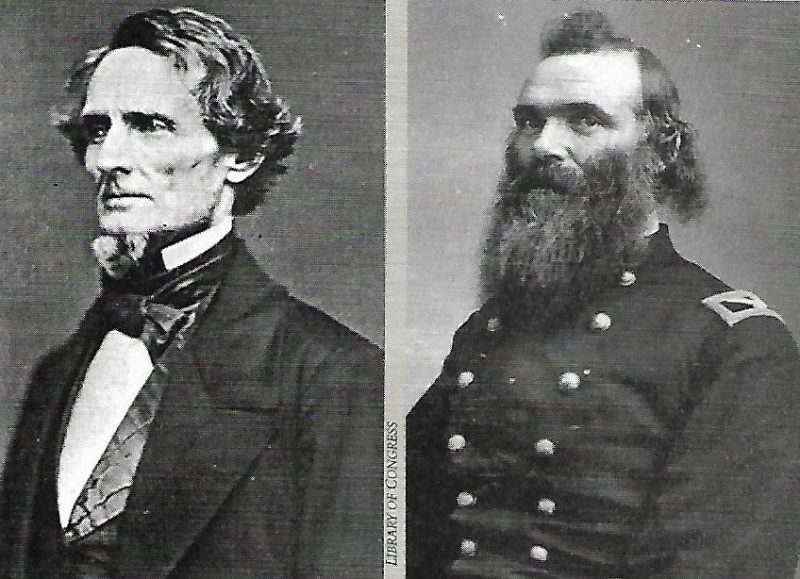 to law. This gave him the power to take possession of railroads and run them as required by the needs of the war. He did not hesitate to use that power when he felt it necessary.
to law. This gave him the power to take possession of railroads and run them as required by the needs of the war. He did not hesitate to use that power when he felt it necessary.
(Photographs above: CSA President Jefferson Davis and Union General Daniel Mc Callum)
Lincoln’s attitude, the firm hand of General Daniel Mc Callum in the War Department and the willingness to pay market rates for rail use, caused most all Northern railroad owners to cooperate.The owners of the railroads became rich doing so as well. General Mc Callum ran (controlled) the largest rail network in the world during the war.
The Confederate government passed similar legislation. But, it was not aggressively used by President Davis. And, Southern railroads did not receive adequate compensation. So, absent force and the carrot of adequate money, cooperation of Southern railroad owners in support of the war effort was tepid at best.
In addition, Southern railroads were weakened by:
1. Lack of replacement rolling stock, rails and spare parts, (all supplied from the North prior to the War.)
2. Several rail gauges in use and non-standard equipment used by 113 RR different companies made coordination & use difficult.
3. Railroads did not have adequate connections to and within cities.
4. Lack of central control: weak leadership in Richmond and ‘states rights’. Made the use of railroads difficult.
Both governments had the stick and both reached similar agreements with the privately-owned railroads. President Lincoln used the stick and President Davis did not. The CSA paid in increasingly worthless bonds while the Union paid in sound currency.
The Union had the will (national control) and much more rail in place to connect major cities as well as the countryside. They also had the capacity to build rail and manufacture spare parts and a seemingly endless amount of rolling stock. The South had none of these capabilities.
The final irreparable damage done Southern rail was the destruction of Southern rail lines by the Union armies fighting on Confederate soil. On his march from Atlanta to Savannah Sherman’s men called what they did to rail lines, Sherman’s Neckties.
CIVIL WAR RAILROADS: 1
Northern Railroads in 1860: 1
Just prior to the outbreak of the Civil War, the United States contained five percent of the world’s population. But, the country contained almost 50% of the world’s rail track.
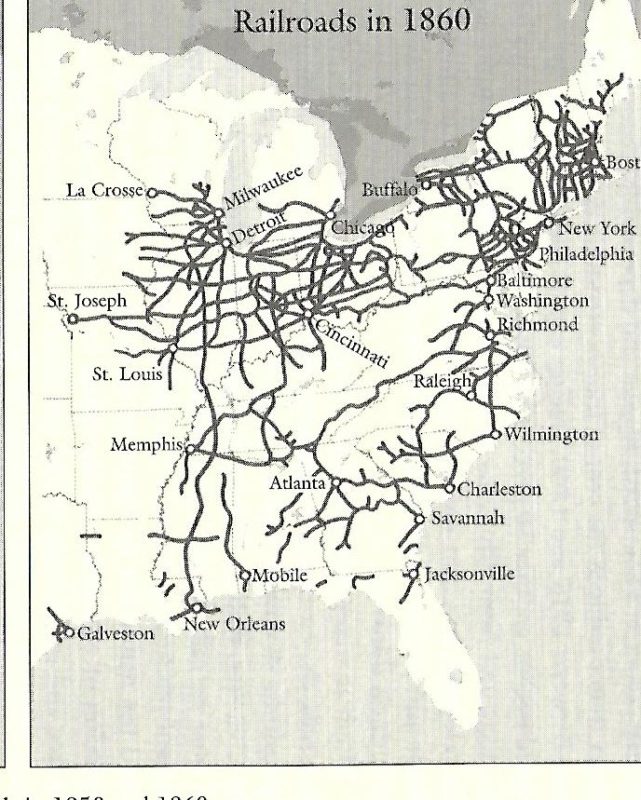
Northern railroads served a rapid growth in industrial needs. Thus, an enormous amount of capital was directed to the expansion of railroads. In the South, however railroads served the agricultural economy’s seasonal needs.Most of the available capital there,went to the acquisition of land and slaves.
I will continue the description/analysis of railroads in the Civil War in the next news letter.
Railroads in the Civil War #1
RAILROADS IN THE CIVIL WAR: Newsletter #1
Just prior to the outbreak of the Civil War, the United States contained five percent of the world’s population. But, the country contained almost 50% of the world’s rail miles.
Northern railroads served the rapid growth of the industrial economy’s needs there. Thus, an enormous amount of capital was directed to the expansion of railroads. In the South, railroads served the agricultural economy’s seasonal needs. Most of the available capital there, went to the acquisition of land and slaves.
As you can see from the above railroad map most of the rail line served the United States in the mid-west and along the east coast. You can also see that because of the rail lines in the Mississippi Valley, rail centers like Nashville, Memphis. Chattanooga, Corinth & Vicksburg became important military objectives of the attacking Union forces.
I will continue the description/analysis of railroads in the Civil War in subsequent newsletters.
WAR IN THE WEST: THE RIVER WAR #1
CONTROL OF THE WESTERN RIVERS
1862
Ulysses S. Grant, a political appointee of the Illinois governor, had been given command of troops stationed in Cairo, Illinois. In January of 1862, Grant suggested to his superior, General Halleck that he be allowed to attack Fort Henry on the Tennessee River and following that attack, Fort Donelson on the Cumberland River. Halleck refused to approve this proposal. It wasn’t that Halleck did not feel the project had merit. Rather, he just did not want to approve such a venture under Grant’s command.
Halleck did not like or trust Grant. His animosity went back to their service days in California. There, Halleck knew Grant as a man who could not hold his liquor; a man who was forced to resign his army commission or face a court martial for being intoxicated while on duty.
But the Grant of 1861 was a sober man. Marriage and family had changed him considerably. This war had given him another chance at something at which he excelled; military leadership. Once the governor of Illinois gave him command of troops, he was determined to succeed.
He had sent some of his men east to occupy the fort at Paducah on the Ohio River in August of 1861. He also enlisted the support of naval Captain Foote for a joint naval/army operation against the two forts mentioned earlier. Halleck knew the strategic importance of these two forts. and, Grant and Foote’s proposal came at the same time Lincoln was putting pressure on Halleck to begin some sort of offensive operation in the West. So, the second time Grant & Foote offered their proposal, Halleck authorized the project.
The approval came at the very time that the new shallow draft military river craft were being delivered to Halleck’s command. In January 1862, naval Captain Foote took delivery of seven City Class ironclads. Designed for river use, they only needed seven feet of water. It was said they could sail on the mist.
These boats provided the foundation for Lincoln’s Brown River Navy on the Mississippi River north of Vicksburg. Their use spearheaded the success of Union forces in that arena during 1862.
The Union’s Brown River Navy defeated it’s Confederate opponent in every engagement.
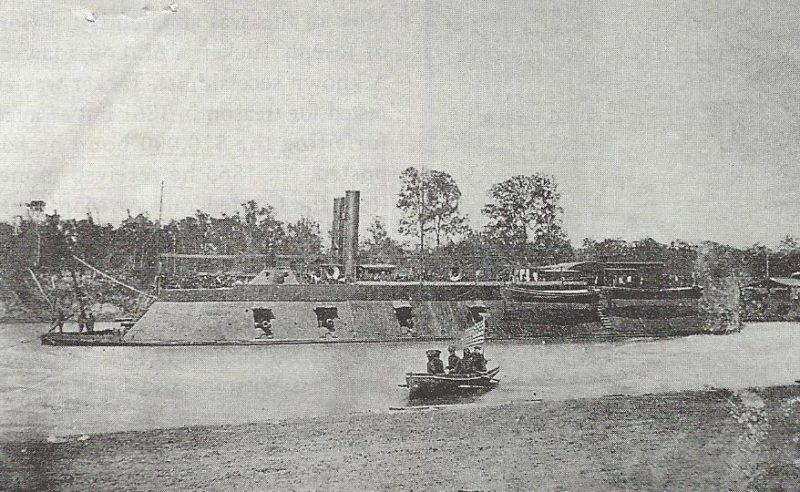
Civil War in the East: Lee vs Union Generals
Once General Robert E. Lee took over command of the Army of Northern Virginia in 1862, he faced, in succession, several celebrated northern Generals. These Union leaders had much larger forces and had more and better equipment at their disposal. Despite that, Lee’s army won his battles against them or at least escaped destruction at their hands during the Civil War in the East.
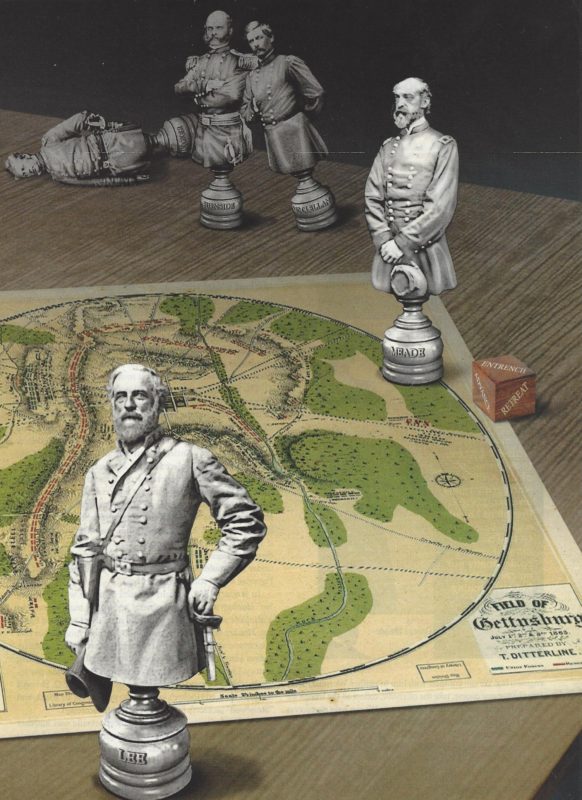
These Union men included Generals Pope, McClellan, Burnside, Hooker and Meade. Only General Meade clearly defeated Lee. but even he, was a disappointment to President Lincoln because he did not follow-up his success at Gettysburg. Instead he allowed Lee to get his defeated army back to Virginia to defend Richmond, the Confederate capital.
It also has been argued that in September 1862. General McClellan defeated Lee at Antietam. But there too, Lee was allowed to escape with his battered army. Lincoln thought Lee’s army could have been destroyed following that battle.
Confederate successes at the Seven Days’ Battles, 2nd Manassas, Fredericksburg, and Chancellorsville together with the high casualty rate at Antietam, took a heavy toll on Lee’s forces.
For example, Lee’s success at the battle of Chancellorsville, cost him almost a quarter of his army. This was followed within two months with his losing an additional third of this same army at Gettysburg; that is, at least 50% of the Army of Northern Virginia’s strength was lost within a three month period.
And later, under the relentless pressure of General Grant’s attacks, Les’s army continued to decline in strength. Finally, in the spring of 1865, Lee surrendered a force of not many more than 10,000 starving men; the remains of the once powerful Army of Northern Virginia.
To view more Civil War blogs go to www.civilwarnovels.com
Harvey’s Oyster Saloon 1863
Located in the worst slums of Washington City and surrounded by brothels and bars, Harvey’s Oyster Saloon catered to solders of all ranks as well as the rich, famous and powerful Washingtonians; President and Mrs. Lincoln included.
According to an 1861 article in the Evening Star newspaper, Tom and George Harvey founded this restaurant before the Civil War broke out. In the pre-war building there were no chairs only elevated tables. A customer could order a gallon of boiled (later steamed) oysters for .25 cents and all the hot butter and freshly baked bread he or she wanted.

Once the city was flooded with troops and those seeking government war contracts, the restaurant seemed to be always jammed. Long lines of customers were commonplace. That’s when the brothers stopped boiling their oysters and went with the faster process of steaming them.
Following the war, the Harvey brothers moved their restaurant to a better part of Washington. They remained a landmark in the city for another century.
WAR IN THE WEST #2
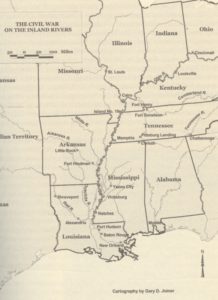 THE RIVER WAR in the WEST
THE RIVER WAR in the WEST
Central to General Winfield Scott’s plan to force the southern states back into the Union was to regain control of the Mississippi River and its tributaries. Toward that end, it was necessary to create, from scratch, a river navy. It would be known as Lincoln’s Brown Navy.
In July of 1861, US Quartermaster General Montgomery C. Megis advertised for proposals to construct ironclad gunboats for use on the Mississippi River. James Eads, a Civil Engineer from Missouri.won the contract with the help of his friend Attorney General Edwin Bates.
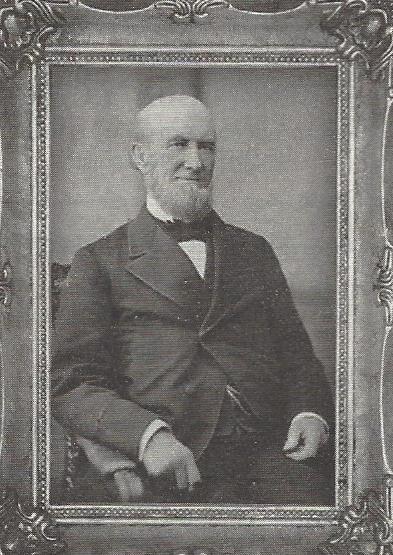
In August, the engineer convinced the War Department to give him a contract to build armed river craft. Known as POOK boats after their designer, Eads (the engineer) agreed to deliver seven of them for $89,000 each by October 5, 1861. For each day the delivery was delayed he would forfeit $200.
Back in St. Louis, Eads constructed the Carondelet Shipyards and trained a labor force of 500 men working in shifts 24 hours a day. Eventually he would have 4,000 men working there and at a second shipyard in Mound City, Illinois on the Ohio River. They would construct low profile armored and armed boats that would only draw seven feet of water; ideal for the western rivers.
On October 12, 1861 the first such iron clad, the Carondelet, was put in the water at Ead’s Missouri shipyard. It was followed by the St. Louis, the Louisville and the Pittsburgh.

These were followed by the Cincinnati, Mound City and the Cairo from the Mound city shipyard. All of the original boats were delivered on time.
The first time one of these boats was used in a combat operation was in support of Grant’s attack at Belmont, Missouri on November 7, 1861. In their next engagement on February 2, 1862, this fleet of iron-clads made possible the successful attack on Fort Henry located on the Tennessee River. A few days later, under naval Captain Foote, the boats were moved to the Cumberland River in support of Grant’s attack and subsequent capture of Fort Donelson.
These POOK boats were next used in the attack on Island No 10 at New Madrid, Missouri. That fortified island was bombarded by mortars mounted on barges on March 13 and was subsequently abandoned by the Confederates. On April 6, two of Ead’s boats assisted Grant hold off General Johnston’s Confederates at Shiloh at the Pittsburgh Landing river site. And they guarded the river at that site for General Buell’s arriving troops.
Ead’s POOK boats swept the river of enemy craft whenever they met. One of them sunk by a Confederate torpedo has been raised and is on display at the Vicksburg battlefield’s Visitor Center. The rest were sold for scrap after the war ended. See more at www.civilwarnovels.com
The Civil War Begins
Lincoln’s inauguration signaled the crises of the two forts, Sumter in Charleston harbor, South Carolina and fort Pickins located in Pensacola, Florida. His predecessor, President Buchanan, had not turned these two forts over to the Confederate government. It was left to his successor to deal with that issue.
Lincoln’s military adviser was General Winfield Scott. When the general was asked his opinion, he recommended abandoning the forts. The majority of Lincoln’s cabinet had endorsed his recommendation as well. Lincoln refused to accept that option but he also refused to speak against it either.
Prior to Nov 11th and the passage of the CSA’s low tariff, northern public opinion, at least in the Northeast, wanted peace. Peace was good for business. But as a tariff war loomed, opinions changed. From the beginning, leaders in the mid-west wanted Lincoln to regain control of the Mississippi river and it tributaries. Industrialists, bankers and merchants in the northeast changed their minds, too. “Collect the Northern tariff at all ports or we will not pay it.” New York merchants threatened. Thus, the issue of keeping the two forts took on new importance.
While northern public opinion was evolving, commissioners sent by the Confederate States of America government traveled to Washington City in an attempt to settle the issue. They were even authorized to pay the Union government for the two forts. Lincoln refused to meet with them because he did not want it said that he recognized their government as legitimate. Secretary of State Seward, however did not hesitate. He met with the CSA commissioners to discuss the issue.
While he was not authorized by Lincoln to do so, Seward assured the Confederate Commissioners that Fort Sumter would be turned over to the government of South Carolina. It appeared that early in the Lincoln administration, Seward believed he was responsible for crafting policies for Lincoln.
President Jefferson Davis was becoming impatient with those talks. He pressured his Commissioners to push for a resolution of the issue to little avail. Finally, he announced to his cabinet that either Union troops were withdrawn from Sumter or the fort would be taken by force.
His Secretary of State, Robert Toombs objected. He argued, that taking Fort Sumter by force would begin a war they could not win. “We have many friends in the North. Attacking Fort Sumter will unite all in the North against us.”
Never-the-less, the President of the Confederate States of America ordered General Bureaugard in Charleston to take the fort by force it it was not abandoned by its commander, Major Anderson. The demand was refused, so the cannons roared in Charleston’s harbor.
Thus, the leaders of the Confederate States of America began a war 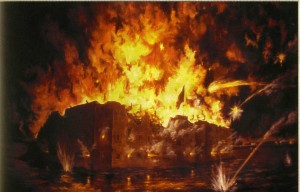 with the Union. The conflict would last four years and cost over 700,000 deaths to military personnel alone. And, as General Winfield Scott warned President Lincoln generations would pass before the bad feelings would subside between people of the North and South. Some people would say bad feeling still exist.
with the Union. The conflict would last four years and cost over 700,000 deaths to military personnel alone. And, as General Winfield Scott warned President Lincoln generations would pass before the bad feelings would subside between people of the North and South. Some people would say bad feeling still exist.
The Union
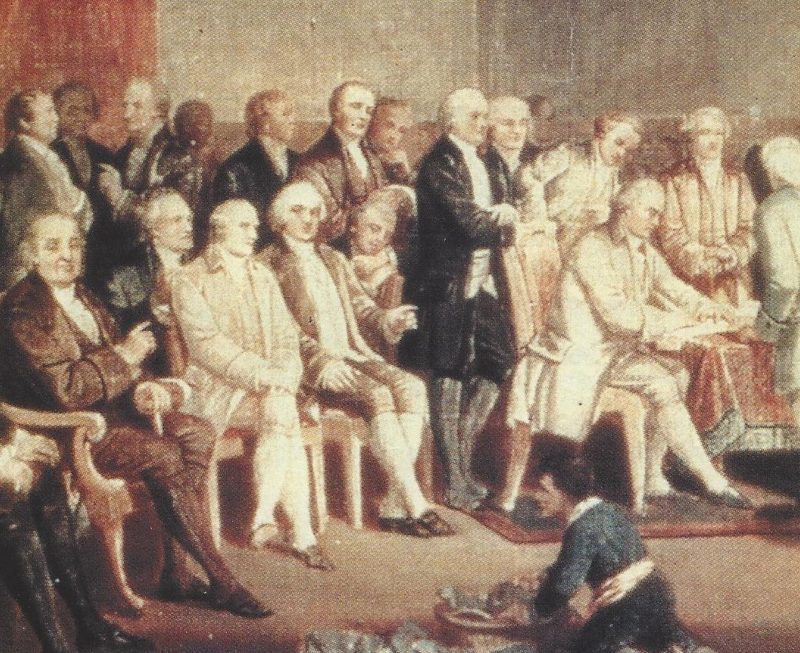
As far back as colonial times, there had been disagreements between the people and leaders of the various sections of the British colonies of North America. United action between the people living as far north as Massachusetts and as far south as Georgia came with the conflicts with France and its Indian allies. By 1763, that unifying force had been eliminated. Thereafter, British Parliament had become the common enemy of the people living in the various colonies when it attempted to impose a Mercantile system in their colonies.
Such a system ran counter to over one hundred-fifty years of freedoms enjoyed by the colonists. Such freedoms had become rights. The colonists all, resented Parliament’s attack on their freedoms so strongly that they went to war with the mother country, the most powerful nation on earth at the time, to keep them; and won.
Their independence was recognized in the Treaty of Paris of 1786. The first attempt at united government resulted in the weak, ineffectual Articles of Confederation. It was soon recognized by many as the new common enemy. This time, it seemed to be the enemy of the proper growth and even the survival of the new nation. Thus, the new challenge was to devise a form of joint governance that allowed for the survival and prosperity of the new nation while at the same time preserving the core freedoms that had been won from Great Britain.
This challenge was taken on by representatives of twelve of the 13 independent states (former British colonies) at a meeting in Philadelphia in May of 1787. As Thomas Jefferson later said of the effort,
“”They (the delegates) laid their shoulders to the great points, knowing that the little ones would follow of themselves.”
Throughout the summer of 1787, the delegates worked to come up with a federal government ” adequate to the exigencies of the Union,” but not so strong as to impinge on individual freedom or the core sovereignty of the various states.
By August of 1788, eleven of the thirteen sovereign states had ratified the new Constitution of the United States. But, it was not without debate and drama. In two of the most important and necessary states, the fate of the proposed Constitution was narrowly decided.
In June of 1788, the Virginia convention delegates voted to adopt the proposed Constitution by a vote of 89 to 79 despite fierce opposition from such patriots as Thomas Paine. In August of 1788, the New York delegates voted to adopt the proposed Constitution by a vote of 30 to 27, despite opposition from the state’s governor and other staunch revolutionary heroes. In both states, the delegates also voted to approve a caveat: If the new federal union did not work to the benefit of their citizens and instead did harm to their prosperity, they reserved the right to leave said Union.
Rhode Island and North Carolina delegates would also adopt the Constitution before year’s end.
Within eighteen months, a federal government under this new constitution would be formed. Thus began the grand experiment. Over the next seventy years, the fabric of this union would be tested repeatedly. Time and again, political leaders would come together, solve the dilemma and avoid a serious tear in that fabric.
But, after 1852, such leaders no longer led the Union. So, when the fabric of the Union would be seriously tested, irretrievable tears would not be avoided.
Was the Assassination a Conspiracy or the Act of a Lone Gunman?
President Lyndon B. Johnson 1971
In 1971, the retired president gave an interview to Leo Sands of the Atlantic Monthly. At that time he said,
“The assassination in Dallas had been part of a conspiracy. I have never believed that Oswald acted alone.”
Life Magazine: On November 25, 1966, Life magazine editors issued the following statement:
“One conclusion is inescapable, the national interest deserves clear resolution of the doubts. A new investigating body should be set up. perhaps at the initiative of Congress. In a scrupulously objective and unhurried atmosphere, without the pressure to give assurance to a shocked country, it should reexamine the evidence and consider other evidence the Warren Commission failed to evaluate.”
Response:
In response to public pressure a congressional committee was appointed to investigate the assassination. The members of that committee spent a year investigating the assassination of President Kennedy. It issued a report on September of 1978 in which the it concluded:
“We believe, and the facts strongly suggest, that President Kennedy was assassinated as the direct result of a conspiracy…”
Response:
But, despite this conclusion no action has been taken by any government body to pursue the matter. As a result, both the flawed FBI Report and the equally flawed Warren Commission Report are still accepted as the final word on the assassination of John F. Kennedy
Read volume one of my two volume study on the assassination. The Kennedy Assassination: Did Oswald Act Alone? Review all the data I presented. Then, make up your own mind Go to the web site, www. The KennedyMurder.com to order signed copies postage included.
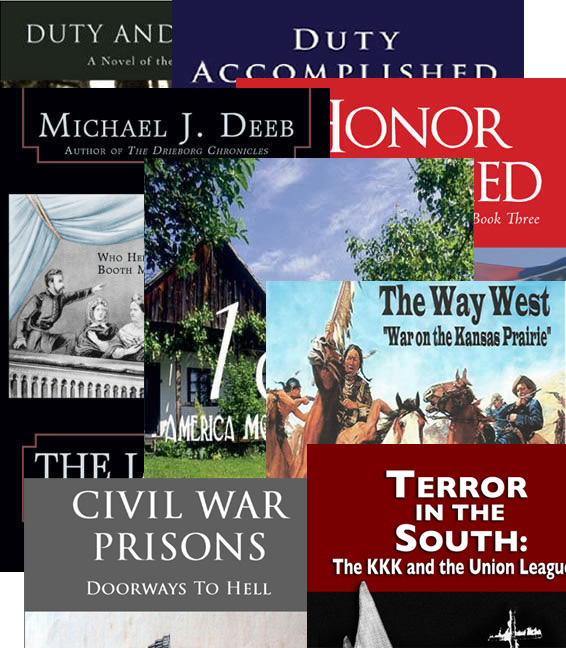
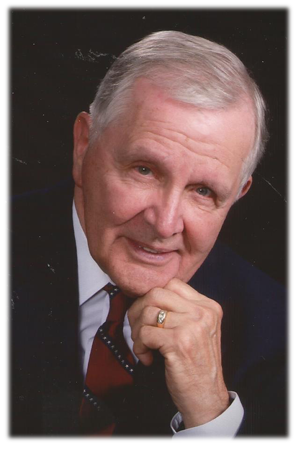
 A Great Read! I couldn’t put this book down once I got started. The detail was great and I really like the main character, Michael. Knowing that so much research went into this book made it exciting to read!
A Great Read! I couldn’t put this book down once I got started. The detail was great and I really like the main character, Michael. Knowing that so much research went into this book made it exciting to read!